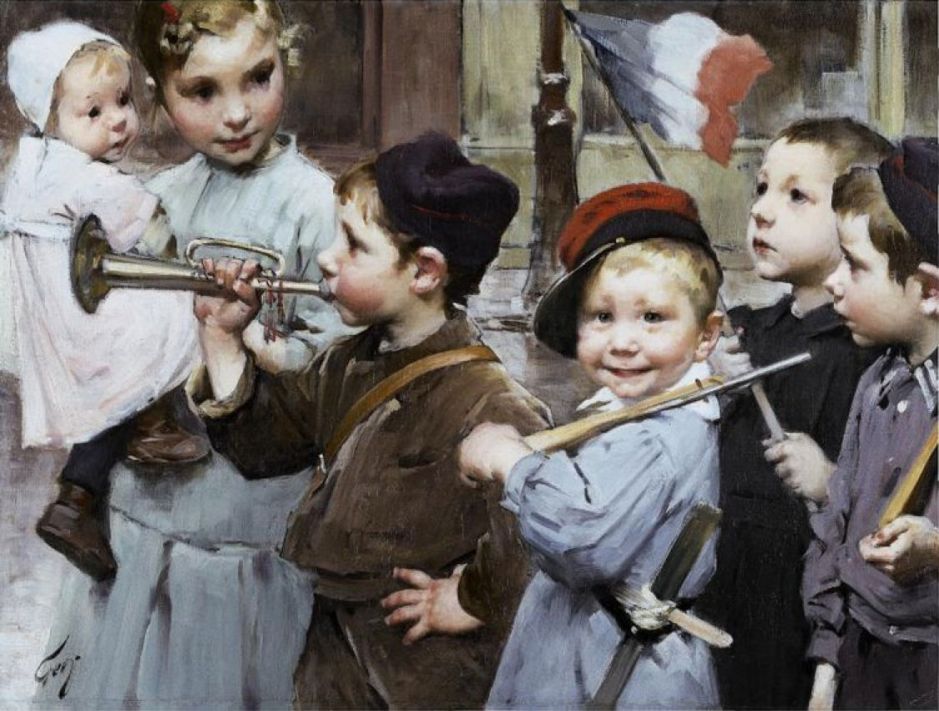Children are most commonly the speciality of women painters, perhaps because they usually work better with child models than do men. One notable exception to this is one of very few artists who specialised in painting children, particularly those in school: Henri Jules Jean Geoffroy (1853–1924).
He was born the son of a tailor in Marennes, on the west coast of France, half way up the Bay of Biscay. He went to study in Paris, probably at the École des Beaux Arts in about 1871, where he is claimed to have been a pupil of Léon Bonnat and others, although Bonnat didn’t become a professor there until 1882.
He first exhibited at the Salon in 1874, when he was just 21. From 1876, he undertook commissions to illustrate books about childhood and youth for the publisher Pierre-Jules Hetzel (1814-86), who also published the work of Gustave Doré, and discovered Jules Verne. Despite this promising start, Geoffroy doesn’t seem to have achieved much artistic recognition until the mid 1880s, by which time he signed himself simply as Geo.

Around 1879-1882, Geoffroy painted this work showing a well-known scene from Victor Hugo’s Les Miserables, of Jean Valjean and Cosette. This shows the hero Valjean when he arrives in Montfermeil on Christmas Eve and discovers young Cosette fetching a pail of water for her abusive guardians the Thénardiers, early in the novel.

He followed this with Whoever Breaks the Glass Pays for It in 1881. This shows a group of three young boys who have apparently broken a glass from a street café. The boy at the right is pointing down at the fragments of glass on the ground, and looking daggers at the other two. He is being admonished by the street vendor whose glass has been broken, and clearly has been told that he has to pay for the damage.
Geoffroy gives subtle insight into the social background in the children’s clothing: the apparently uninvolved boy at the left wears clean and fancy boots, while the one at the right who is assumed to be the miscreant wears worn and dirty clothing and footwear.

By 1882, Geoffroy had entered the schools where he was to be most successful and prolific; he apparently lodged above a school, with a couple of teachers. Snack Time shows the pupils outside their primary school during a break, armed with their lunchboxes and baskets. Again he tells their stories using subtle hints including their clothes. A well-dressed girl in white is being harrassed by a smaller boy into surrendering some of her food. He wears rougher clothes but seems in control of the situation, as others watch on and laugh.
In 1885, he was appointed a knight in the Legion of Honour.

Geoffroy’s painted insights into the world of childhood extend to illness and the hospital. In his dazzlingly modern and clinical Visiting Day at the Hospital from 1889, the boy’s father clearly could never have afforded state-of-the-art care for his sick son. Although probably understood by the contemporary viewer, the painting doesn’t reveal to modern eyes that the boy is most probably dying of tuberculosis, an all too common problem then.

In Primary School Class from 1889, Geoffroy shows one of the new lay teachers working diligently in the classroom with her pupils. This was clearly deemed sufficiently positive to the Third Republic as to be purchased by the French National Ministry of Education, where it still hangs.

Less welcomed by the State was The Night Hostel or The Soup Kitchen from 1891, showing homeless women and children being fed and sheltered in what appears to be almost a prison.

Returning to school scenes in 1895, Geoffroy shows a Drawing Lesson in a class of older boys, who are following the classical tradition of drawing casts and appear remarkably diligent and well-behaved.

Geoffroy’s The Nursery from 1899 is one of very few paintings which show modern approaches to the early rearing of children under the Third Republic. Hospitals developed a rigorous almost military approach to nurseries and feeding which endured well into the twentieth century, and separated mothers from their infants for much of the time.
In 1900, at the Exposition Universelle in Paris, Geoffroy was awarded a gold medal, forming the peak of his career.

In Geoffroy’s In School from about 1900, another lay teacher in a modern Republican infants class is caring for the French men and women of the future.

Bastille Day, from the same year, shows a group of children celebrating the national day of France on 14 July. For young boys in the years before the First World War, this was becoming increasingly militaristic rather than just patriotic.

I have been unable to locate an image of Geoffroy’s painting from which Charles Baude made this print of Prize-Giving at an Infants School in 1904, but it is a fine example of the artist’s depictions of groups of young children and their social interactions.

This undated painting of It’s Hard to Share shows another of the tribulations of childhood. These young boys have just emerged from a sweet shop, and the child in the centre is reluctant to share the paper cone of sweets which he has just bought. His face says it all, as he looks with great suspicion at his less fortunate friend, and a dog looks up expectantly too.
I have been unable to find any of Geoffroy’s later paintings, and he died in Paris in 1924, at the age of 71.
Geoffroy was a Naturalist painter whose works not only give great insight into the world of the child, but also reflect the realities of the day. Medicine in the late nineteenth century had improved greatly, and the French State was making big strides forward in making it available to all, but very many children never survived to be adults.
Like most Naturalist artists, Geoffroy had an important role in showing people the remaining injustices in society. His paintings are a valuable record of the times.

